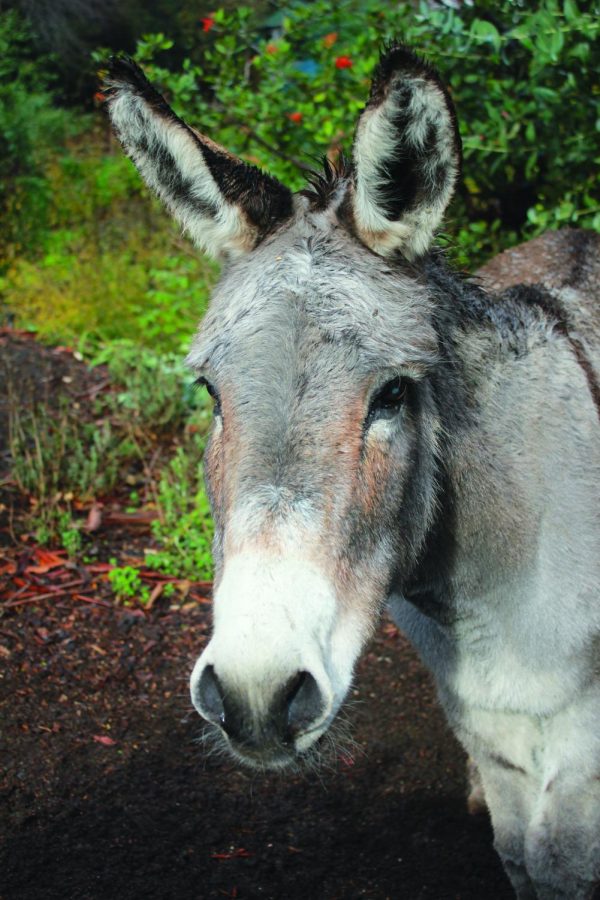Palo Alto community bonds over Bol park donkeys
Along the winding bike path leading out from campus and past the baseball fields, the Veterans Hospital and the old wooden bridge, there lies a one-acre pasture that houses two Palo Altan icons: the Bol Park donkeys. Perry and Jenny, along with their caretakers, have become an integral part of the Barron Park community.
Perry, the older and more famous of the two, is a miniature Jerusalem donkey who arrived at the Bol Park enclosure in 1997 and is currently 24 years old. Sporting long, velvety ears, a muddy grey-brown coat, a couple of missing teeth and a feisty nature, this alpha male served as the inspiration for the character Donkey in DreamWorks’ “Shrek” franchise.
One of the primary caretakers, Jenny Kiratli, shares her name with the most recent addition to the donkey pasture: a standard donkey who arrived on Nov. 15, 2016. According to Kiratli, Jenny the donkey lived in Southern California for 15 years, but her exact age is unknown. “When they take them out of the Mojave desert, it’s just like a dog adoption,” she said. “They give you an estimate, but if they’re adults, they can’t always tell.”
Jenny’s most notable characteristics include her long, luxurious eyelashes, her smarts and her gentle yet headstrong nature. “She’s the one who figured out how to open the shed door—broke the handle clean off. That’s why we have three handles on the lock and a latch there to keep them in,” Kiratli said.
While at first the handlers were hesitant to put the two donkeys together, they since have established a unique relationship. “When she arrived, we originally had sort of a fence in the middle because we just weren’t quite sure how Perry would do and didn’t know anything about [Jenny’s] temperament, but he made it clear that he was in charge and the alpha male, and now she does a funny thing: she just sort of follows him around,” Kiratli said.
The Bol Park donkeys found their fame from the “Shrek” movies. Niner, who passed in September 2016, had originally been chosen to model the character of Donkey, but he displayed a clear lack of interest in interacting with the crew members. “He wouldn’t come up and at some point, he came to the gate and was chewing on the director’s boots,” Kiratli said. “He did not make a good impression.”
Perry was cast as the second choice, and Kiratli believes his personality made all the difference. “And meanwhile here’s little Perry, who’s probably four or five at the time, and he was just sort of bouncing around like, ‘Me, me, me,’ so they used him instead of Niner,” she said.
Even today, Kiratli can fondly recall watching the movie and noticing the exact mannerisms and feisty nature displayed by Donkey that she sees in Perry. “Donkey does things like tossing his head and rolling his eyes and stamping, and all of those behaviors came straight from Perry,” she said.
As the Director of Clinical Research and Spinal Cord Injury at the Veterans Affairs Hospital, Kiratli believes the expertise she has derived from the medical field has directly translated to her ability to care for the donkeys and serve as the head of the Barron Park Donkey Organization.
The efforts of Kiratli and other volunteers have contributed to the donkeys becoming an essential facet of the community. Kiratli believes that the donkeys are a way for kids to reconnect with nature and Barron Park’s rural past. “You know, kids grow up here thinking that it is not abnormal to have a donkey in your backyard,” Kiratli said. “It is a very calm place to be. They are gentle, and I think a lot of people come here just to sit and relax. I really do like that it’s not mechanized; there’s no technology—there are donkeys, and it’s very natural.’’
Unfortunately, there have been reports of students treating the donkeys poorly, a behavior Kiratli hopes will stop with support from the community. “It is not fun to do damage to the donkeys, and so we have to trust the community to help us take care of them,” Kiratli said. “I would really like everyone to be vigilant and look out for misbehavior.”
In addition, despite signs, people still continue to feed Perry and Jenny, which can lead to serious consequences. “That’s really a problem because when somebody feeds them and then somebody doesn’t, they get nippy with the people who don’t, which is dangerous for the community,” Kiratli said. “Perry’s also missing a lot of teeth so he can’t chew very well, and if people feed him big hunks of food or big handfuls of grass or hay, it could actually get caught in his esophagus, and it can be very dangerous.”
This is not to say the community has not given back to the donkeys. The pasture is primarily supported by donations, and the organization is always looking for more to help out with the care and well-being of Perry and Jenny. “It’s all community donations, and we lease the property from the owner,” Kiratli said. “We want to engage the community, and we want people to donate too.”
Both Perry and Jenny are brought to Bol Park every Sunday morning from 10 to 11 a.m. where people can come up and interact with them. The donkeys are also known to participate in a number of traditional Barron Park activities. “The Sunday evening feeder feeds them at the gate, [tells] stories and has kids help at 4 p.m.,” Kiratli said. “They routinely go to Barron Park [Elementary School] on Earth Day, and they always come out to the May Fe?te parade and movie night, so they’re always involved in the community.”
Your donation will support the student journalists of Henry M. Gunn High School. Your contribution will allow us to purchase equipment and cover our annual website hosting costs.


